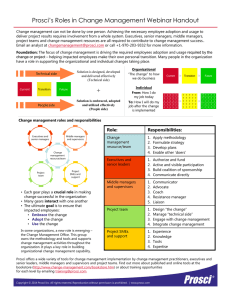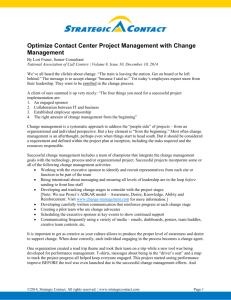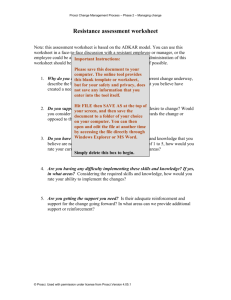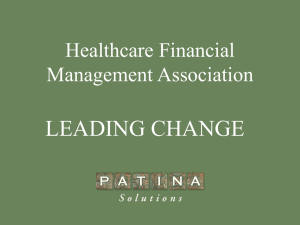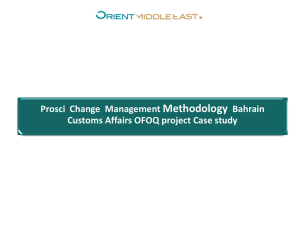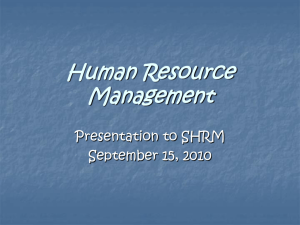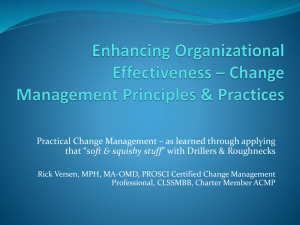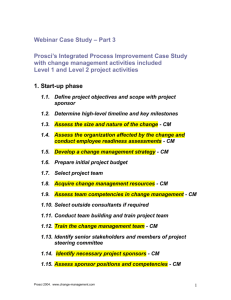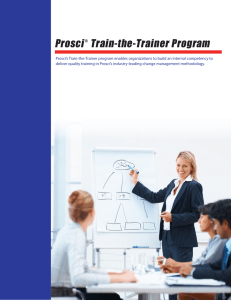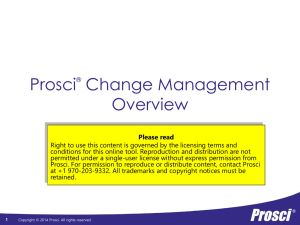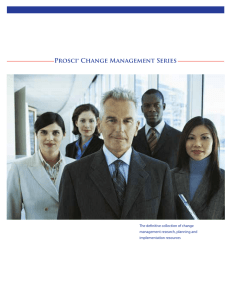Paul Dickin
advertisement
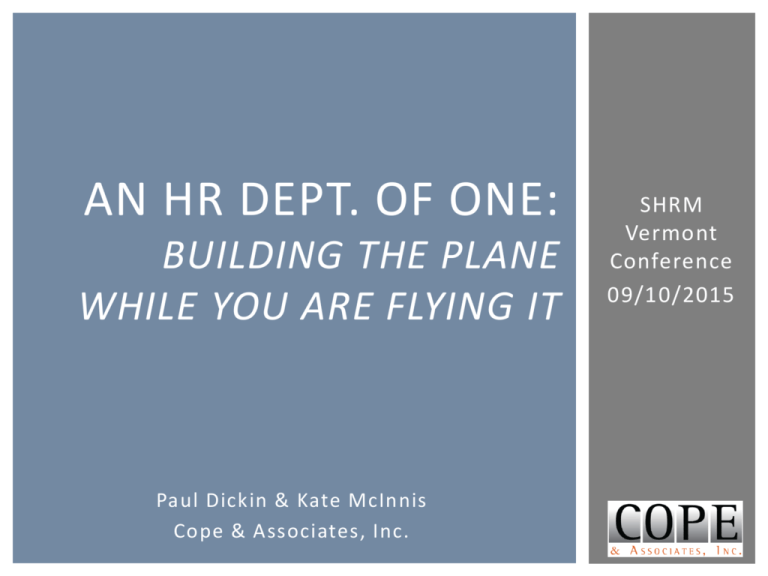
AN HR DEPT. OF ONE: BUILDING THE PLANE WHILE YOU ARE FLYING IT Paul Dickin & Kate McInnis Cope & Associates, Inc. SHRM Vermont Conference 09/10/2015 1 Agenda: 1. 2. 3. 4. 5. 6. Introductions Overview of Change Process HR as it Relates to Change One Story of Change Where to Start, Is there a Map? Questions & Responses SHRM VERMONT CONFERENCE 09/10/2015 2 1. INTRODUCTIONS Presenters: Rebecca Bowen And You Are? (CVHHH) Paul Dickin (Cope & Associates) Kate McInnis (Cope & Associates ) 3 2. OVERVIEW OF THE CHANGE PROCESS SHRM Vermont Conference 09/10/2015 THE SCENARIO: DOES THIS RESONATE? The CEO is talking “Culture Change” The CEO is not talking “Culture Change” HR processes are old/incomplete/… “missing” Old habits and community culture are rampant The “HR Team” is just me! 5 REGARDLESS OF THE IMPETUS… …We are talking about change management 6 “CULTURE CHANGE” HAS TO: Define what you are going to STOP, what you are going to START, and what you are going to CONTINUE doing; Have a clearly articulated vision; Be about behaviors, not words; Be managed over an extended time period. 7 KEY PRINCIPLE Accountability Loop Source: Adapted from: Accountability Revolution, Mark Samuel 2000 8 EFFECTS OF ORGANIZATIONAL CHANGE MANAGING CHANGE & TRANSITION Endings Transitions Beginnings Productivity GAP Effort Change 9 INTEGRATION OF PROJECT MANAGEMENT AND CHANGE MANAGEMENT Project management Current state Transition state Future state Change management Solution is designed, developed and delivered effectively (Technical side) + Solution is embraced, adopted and utilized effectively (People side) = Success Project management and change management have a joint value proposition oriented toward business results. PROSCI ® IMAGE LIBRARY SOME RELEVANT DATA TO INFORM US Correlation of change management effectiveness to meeting project objectives 100% Percent of respondents that met or exceeded project objectives 90% 95% 80% 80% 70% 60% 50% 49% 40% 30% 20% 10% 17% 0% Poor (n=177) Fair (n=441) Good (n=561) Excellent (n=107) Overall effectiveness of change management program *Data from 2007, 2009 and 2011 © Prosci. From Prosci’s 2012 Best Practices in Change Management benchmarking report SOME (MORE) RELEVANT DATA TO INFORM US The number one obstacle to success for major change projects is employee resistance and the ineffective management of the people side of change. Data from 327 companies undergoing major change projects; Prosci Best Practices in Business Process Reengineering benchmarking study. Copyright Prosci 2009 RESISTANCE TO CHANGE Why do people resist change? How do people resist change? 13 CHANGE MANAGEMENT TRINITY (CAJUN PARALLEL) Click to edit style ® Prosci PCTTM Model (EVEN MORE) RELEVANT DATA TO INFORM US Correlation of sponsor effectiveness to meeting project objectives 90% 85% Percent of respondents that met or exceeded project objectives 80% 73% 70% 60% 50% 40% 30% 36% 40% 20% 10% 0% Sponsor was very ineffective (average score < 2) Sponsor was Sponsor was effective Sponsor was very ineffective (average (average score effective (average score between 2 and between 3 and 4) score between 4 and 3) 5) Sponsor effective rating average © Prosci. From Prosci’s 2012 Best Practices in Change Management benchmarking report PHASE 1 Denial PHASE 4 Commitment SHRM Vermont Conference 09/10/2015 PHASE 2 Resistance PHASE 3 Exploration 16 Prosci Model THIS ISADKAR IMPORTANT! ® Click to edit style ® THIS IS JUST AS IMPORTANT! ® Change Management Maturity Model ™ Prosci Prosci Change Management Maturity Model TM Level 5 Organizational Competency Click to edit style Change management competency is evident in all levels of the organization and is part of the organization’s intellectual property and competitive edge Continuous process improvement in place Level 4 Organizational Standards Organization-wide standards and methods are broadly deployed for managing and leading change Selection of common approach Level 3 Multiple Projects Comprehensive approach for managing change is being applied in multiple projects Examples of best practices evident Level 2 Isolated Projects Some elements of change management are being applied in isolated projects Many different tactics used inconsistently Level 1 Adhoc or Absent Little or no change management applied People-dependent without any formal practices or plans PROSCI Highest profitability and responsiveness Highest rate of project failure, turnover and productivity loss ® IMAGE LIBRARY KEY ROLES IN CHANGE MANAGEMENT: WHERE IS HR? Enabling Employee-facing Executives and senior managers Middle managers and supervisors Executives and senior leaders – fulfilling the role of sponsors of change Middle managers and supervisors – fulfilling the role of coach for their direct reports Change management resource/team Project team Project support functions Change management resource or team – applying a structured approach and enabling others Project team – integrating the “people side” of change Support functions – providing expertise ® PROSCI IMAGE LIBRARY 3. HR AS IT RELATES TO CHANGE SHRM Vermont Conference 09/10/2015 ESSENTIAL HR ELEMENTS IN ANY CHANGE PROCESS COMPETENCIES, TALENT DEVELOPMENT & SOURCES OF TRUTH Don’t Fool Yourself, “Culture Change” is all about behavior change and individual accountability, supported by: Systems Processes Modeling Language Consequences 22 COMPETENCY DEFINITION The capability to apply a set of related knowledge, skills, and abilities to successfully perform functions or tasks in a particular job, job group, and/or work setting, etc. 23 COMPETENCY MODEL DEFINITION A collection of competencies that together define successful performance in a particular job, job group, and/or work setting, etc. Occupational Industry Related Foundational 24 COMPETENCY MODEL USED FOR SUPERVISOR DEVELOPMENT 25 RESEARCH 26 SUPERVISOR COMPETENCIES Leading the Organization Leading Others Leading by Personal Example 27 CVHHH COMPETENCY MODEL 28 “SOURCES OF TRUTH”: ORAL – WRITTEN EVOLUTION IS TRULY A CULTURE CHANGE Oral Culture X X X X X X Art of Negotiation Inconsistency Individuality Dependency Tribal Knowledge Legend & Folklore Written Culture Regulation Consistency Accountability Initiative Documented Standards Systemic & Dependable 29 “SOURCES OF TRUTH” Mission & Values Statements Employee Handbook Code of Conduct Job Description Performance Management System Talent Development System 30 4. ONE STORY OF CHANGE SHRM Vermont Conference 09/10/2015 CONTEXT CVHHH has 213 employees, the third largest Home Health agency in Vermont HR department of 2.2 FTEs New HR Director replacing 21-year retiree Agency Strategic Plan activated HR Strategic Plan developed but not activated 32 WHERE TO START? I. Top three organization pressure points identified by CEO: High cost of Workers Compensation, Haphazard recruitment protocols, & Lack of HR involvement in Agency operations 33 HOW TO START? II. Link the three problems together, addressing all three by improving Human Resources accountability and consistency 34 STEP ONE Employee safety is linked to employee retention and satisfaction - which is linked to workers compensation premiums. 1. Activate Employee Safety Committee 2. Implement post-offer/pre-employment physical examinations for new hires 3. Improve Employee Incident Reporting 4. Continuous safety alerts for all employees 35 STEP TWO Employee HR management is linked to recruitment and retention by 1. Updating application and screening procedures, increasing involvement of supervisors, 2. Update employee handbook and HR policy manual to improve consistency 36 STEP THREE Changing Human Resources attitude to a “cando” department that is always thinking 30, 90, 360 days ahead 1. Developing first protocols for employee discipline 2. Developing employee satisfaction survey 3. Management training on supervisor competencies (most difficult lift, but will have the most impact) 37 9 MONTHS MEASURABLE RESULTS Days lost from work down to 39 year-todate compared to 118 lost days from work this same period last year Monthly Wellness program inservices that are moving us into the direction of culture changes. Requiring HR integration and reporting into all staff and middle-management meetings 38 5. WHERE TO START WHERE’S MY MAP? SHRM Vermont Conference 09/10/2015 WHERE DO I START? Organizational Clock Model Systems/ Infrastructure Organizational Structures Business Processes Process Systemic Elements Performance Management Leadership People Leadership Alignment Mission & Vision Goals & Objectives Enterprise Risk Management Foundation Elements Strategies &Tactics Communications Enabling Elements Stakeholder Engagement Human Capital People Process Strategy Strategy Values & Operating Principles ©Cope & Associates, Inc. 2007 40 WHERE DO YOU START? Take a moment to think about all you’ve heard, and what resonated with you; Think about your organization pressure points and how they fit with strategic priorities; Write down 1-3 initiatives and what value they would add if improved; Be willing to share with the group. 41 SCOPE OF SERVICES August 25, 2015 Paul Dickin, Cope & Associates 42 NETWORKING MAP This is a very simple way of graphically representing a way of being intentional about building and maintaining a change management network 43 NETWORKING MAP Use the handout to fill in who you think are your allies in this process; Who are your assets, your weakest links?; What are you missing?; Identify potential resources; Prepare a proposal to engage your highestlevel sponsorship and a budget to support your needs. 44 CHANGE MANAGEMENT SPONSORSHIP MODELS Simple Sponsorship Model Complex Sponsorship Model PROSCI ® IMAGE LIBRARY 45 6. Q & R: QUESTIONS & RESPONSES SHRM Vermont Conference 09/10/2015 THANK YOU Kate McInnis Paul Dickin kate@consultcope.com pdickin@consultcope.com 47 BIBLIOGRAPHY • • • • • • • • • B i s h o p, C h a rl e s H . M a k i n g C h a n g e H a p p e n O n e Pe rs o n a t a T i m e . N ew Yo r k : Am e r i can M a n age m e nt As s o c iati on 2001. C h a rl e ne , L I . G r o u n d swe l l . Fo r re ste r Re s e a rc h, I n c . 2008. C o n n or, D a r r yl R . M a n a g i n g a t t h e S p e ed o f C h a n g e . N ew Yo r k : V i l l a rd B o o ks. 1993. D eev y, Ed wa rd. Cr e at i ng t h e Re s i l ient O r g a n i za t i o n . E n g l ewood C l i ffs : P rent ic e H a l l , I n c . 1995. G a r f i e l d, C h a rl e s. Pe a k Pe rfo r mer s . N ew Yo r k : W i l l i a m - M or row a n d C o m p any, I n c . 1986. M c C a l l , J r. , M o rgan W. a n d Ka p l an, Ro b e r t E . W h a tev er I t Ta ke s : T h e Re a l i ti es o f M a n a g e r i a l D e c i s i o n M a k i n g . U p p e r Sa d d le R i ve r : P re nt ic e - H all , I n c . 1990. Pete rs, To m . T h r i v i n g o n C h a o s . N ew Yo r k : H a r pe r a n d Ro w. 1988. P r i tc hett, P r i c e . Af ter t h e M e r g e r: M a n a g i n g t h e S h o c k wa v es . D a l l as: P r i tc hett & As s o c iate s , I n c . 1985 . Sco tt , C y nth ia D. a n d J affe , D e n n i s T. M a n a g i n g O r g a n i za t i o n a l C h a n g e . C r i s p P u b l i cati ons. 1989. 48
